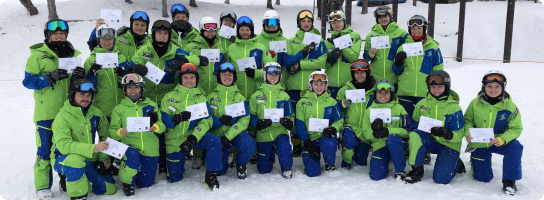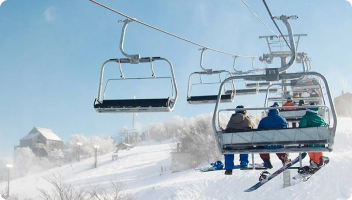Niseko Jobs & Working A Ski Season in Niseko
Discover information on working a ski season at Niseko and browse our Niseko jobs.
View jobs & employers
Niseko is one of the most popular resorts in Japan, and one of its most well-known resorts internationally, attracting visitors from all over. The snow is huge at Niseko. With 15 – 16m of annual snowfall, it has one of the highest average annual snowfall of any resort on the globe. Working at Niseko for a season provides the opportunity to ride all four resorts at Niseko and ski some of the deepest powder on the planet.
Train & Work As A Ski/Snowboard Instructor
Spend a full winter training, qualifying and working as a ski/snowboard instructor in Japan or Canada. All-inclusive packages designed for people with no prior instructing experience.
Why Work in Niseko for the Ski Season?
Niseko isn’t just famous for its incredible snow conditions; it’s also a fantastic place to spend a winter season as a seasonaire. In fact, English-speaking workers are often in high demand… Due to the growth in international tourism demand for the ski area, it has led to some pretty fantastic reasons to choose it as a ski season destination.
Reasons to do a season in Niseko include :
- It’s one of Japan’s largest ski resorts, meaning that even after several months, you won’t get bored and will continue to progress. Plus, Niseko is a great base for exploring nearby Hokkaido resorts like Rusutsu and Kiroro.
- Niseko has one of Japan’s best après-ski scenes. While you won’t find late-night slope parties, there are plenty of bars that stay open late (including the famous Wild Bill’s!).
- The resort is one of the more Westernised ski areas in the country, making it easy to find pizza, burgers, tacos, roast dinners, and many other home comforts.
- While Niseko is one of Japan’s pricier ski resorts, it remains relatively affordable compared to those in the US, Switzerland, Canada, New Zealand, or Australia. Niseko has plenty of lower-cost food trucks, access to large supermarkets, and a favourable exchange rate in recent years. Japan’s inflation rate has also stayed low, unlike many other countries grappling with cost-of-living increases.
- Each winter, more companies are hiring, which means some employers are even prepared to support your travel costs or give you additional bonuses for choosing to work for them
- In terms of other benefits and work perks it will vary by employer, but most companies will offer a ski lift pass as part of your employment package. Given the rising cost of lift passes, this is definitely a plus.
Common Ski Season Jobs in Niseko
With a large number of Western organisations operating in Niseko and an increasing influx of international tourists, there are many job opportunities available for various skills in the area. While the official resorts primarily hire Japanese staff, they are increasingly welcoming English-speaking foreign workers as well.
On the mountain Jobs in Niseko can include :
- Ski and snowboard Instructor (certified already)
- Ski Patrol (usually required to be Japanese)
- Snow Cat / Groomer Operator (usually required to be Japanese)
- Terrain Park Attendant (usually required to be Japanese)
- Lift Operator (often favoured to Japanese persons)
Off the mountain jobs in Niseko can include :
- Rental and Ski Technician
- Retail or Shop Staff
- Guest Services / Front Desk
- Housekeeping / Cleaners
- Cooks, Chefs, and Kitchen Staff
- Baristas, Bartenders, and Wait Staff
- Maintenance Workers / Snow clearers
- Resort Operations / Management
See Jobs Available at Mountain Resorts for a further description of the different ski resort jobs.
When and How to Apply for Ski Jobs in Niseko
It is advisable to arrange a job before going to Niseko. Historically it has been quite difficult to simply show up in Niseko and find a job. Each year, a lot of people do so, and a lot end up just buying a season ticket and riding for a couple of months until the money runs out as they are unable to find a job. The best way for international applicants to obtain a job for a winter season is to contact a company that operates in one of the resorts at Niseko. Many jobs in Niseko do not require Japanese language skills as you will interact mainly with foreigners.
The hiring period for Niseko usually begins around June/July, but will run for several months as the season approaches.
There are a few different ways to find a job in Niseko, you can learn more in the section below, as well as some of the typical employment companies.
Types of Seasonal Employers in Niseko
Working for the official Niseko United Ski Resorts
Working for the resort itself in lift operations, mountain operations etc. is difficult unless you speak Japanese. The resorts at Niseko mostly look for Japanese speakers to fill these jobs. In fact, most of the jobs on the mountain such as lift operators go to the old Japanese potato farmers who farm potatoes in the summer in the area and work for the resort in the winter. As much as the Japanese welcome the tourists, they tend to prefer hiring Japanese instead of the foreigners who arrive each season.
In recent winters, more Niseko jobs have been opened up to foreigners, but it is still rare. Of the resorts, Niseko Village is one of the resorts that hires the most English-speaking staff members.
Working for private companies in the area
(1) Tour Companies in Niseko
Tour companies operate in Niseko that look for English speakers each season to work with foreign guests. Jobs would include driving guests around, welcoming guests, ushering at hotels. Niseko Powder Connection is one such company.
Another company that works out of Niseko is Niseko Base Snowsports. Through this company, you can work as an instructor, in the rental shop, front of house administration and in the retail shop. Again, get in early as the positions fill up quickly.
Other tour companies operating in Niseko which look for English-speaking employees each season include:
- Ht Holidays
- The Niseko Company
- Ski Japan
- Hanazono Powder Guides
- Vacation Niseko
(2) Ski and Snowboard Instructors
If you have your instructing certificate, you could apply to work with the resort as an instructor.
All the lessons are conducted in English and cater especially to foreign visitors. Instructors usually come from Australia, New Zealand, North America and Europe.
See Work a Japanese Snow Season for information on converting your international instructing certificate.
(3) Local Businesses
There are also a few local businesses such as hotels which look for foreign staff each season. Often you can just email these businesses with your CV and a cover letter.
- HTM Niseko is one of the largest employers in the Niseko area, with a variety of roles across their businesses (https://www.htmniseko.com/careers )
- KutChannel (niseko.jaga.io/) has general job listings, often in Niseko
- Ski and snowboard forums like SnowJapan (www.snowjapanforums.com/) may sometimes have job listings for businesses and tour operators looking for employees in Niseko
- NISADE might have options (nisekoalpineaccommodation.com)
- Japan Ski Experience (https://japanskiexperience.com/jobs/)is a growing employer
(4) Internships
There are a few companies which organise internships and working holidays to Niseko. Jobs in Niseko can be tough to find, so this is always a safer, easier option. You will need to pay these companies but they can help place you into work. These companies include:
- WE ARE SNO – Ski Instructor Internships in Japan
- BoobooSki
- iNNi Consulting
- Japan Internships
- SAN Consulting – you must already be in Japan to apply.
Getting a Visa to work in Niseko
Like many ski resorts around the world, the cost of living and ongoing property development have made it more expensive to be a winter seasonaire in Niseko. That said, it’s still relatively affordable compared to other destinations globally.
Some of the companies operating in Niseko offer staff housing, and this is generally a good first step since it can be difficult to rent a place for the season—especially if it’s your first time. After discussing accommodation options with your employer, you can also explore Facebook groups where you can post and search for housing.
It is getting very difficult to get seasonal accommodation in Hirafu. It is easier to do so in Kutchan and even easier in Niseko town. You can read more below. Most real estate owners require a Japanese guarantor and rent upfront due to so many foreigners either not paying rent or causing damage to the building.
The cost of utilities is not cheap in Japan. Also, you will need to either snow clear yourself or contract a snow clearer (moving 15 meters if snow is a lot of work!).
Cost of Living and Staff Accommodation in Niseko
Japan has working holiday visas for citizens of Australia, New Zealand, Canada, the Republic of Korea, France, Germany, the United Kingdom, Ireland, Denmark, and Norway and for residents of Taiwan and Hong Kong.
To get a visa, you are not required to already have a job offer. Applicants need to be aged between 18 – 30, must have proof of sufficient funds ($US 2,000) and must be in good health and not have a criminal record. The working holiday visas are offered once, but can be extended again for up to 18 months. See more information and apply for the visa through on the Japanese Ministry of Foreign Affairs website.
However, you should start applying for your working holiday visa as early as possible as there are a limited number offered each year. March is a good time to start applying. Visit this page for more information on employment and employers in Niseko.
Niseko has a large range of short-term accommodation options for when you first arrive, including hotels and hostels.
Staff accommodation / housing in Niseko
Because Niseko is split across four different areas, your experience will largely depend on where you are based for the season. While there are some buses connecting these villages, after 10 p.m., it can be difficult to move between them as taxis are hard to come by.
Hirafu (or Grand Hirafu) is the most popular area to live in. It’s a buzzing village with bars, restaurants, and a vibrant nightlife, especially by Japanese standards. However, rental prices are high, and it’s becoming increasingly difficult to find accommodation due to ongoing property development.
Niseko Village is the second-largest ski village. For many years, it was primarily dominated by a large Hilton hotel, but in the last five years, it has developed significantly. There are now restaurants, bars, and a variety of accommodation options for tourists. Niseko Village staff have access to nearby staff housing.
Niseko Hanazono is a newer area, but there is no significant staff accommodation available. After lifts stop spinning it will be quiet here.
Niseko Annupuri does have some accommodation, but it’s quite far from Hirafu and Kutchan. It’s not advisable to stay here unless you have access to transportation.
Staff accommodation / housing in Kutchan
Increasingly, housing is being offered or found more easily in Kutchan town, just a short 10-minute drive to the ski lifts or Hirafu. To be honest, this isn’t necessarily a bad thing as long as you have transport. In Kutchan, you’ll find more affordable, well-stocked supermarkets, cheaper restaurants, and a growing number of seasonaire-friendly bars. In recent years, many major employers have purchased or built accommodation in Kutchan, so you can expect to enjoy your time living here over winter. Plus, you’ll pay less rent than you would for a bed in Hirafu!
What to expect on a Niseko ski season
Below are a few other bits of information which could help you plan or budget for a ski season in Niseko.
Work, Pay and Tax
How much you get paid will depend on the job role, however many jobs will pay between 1000 and 1500 JPY per hour. Working hard, you could earn a monthly wage of approximately 180,000-250,000 JPY. Most contracts will run from late November until the end of March.
You will be expected to work hard in Niseko, but due to the number of powder days the resort receives, and the expensive night skiing, you will also be able to get on the slopes a lot. Niseko tends to have a few busy weeks including Christmas, New Year, Chinese New Year and Thai New Year.
The first tax bracket in Japan is 5% and the second is 10%. You will also be required to contribute to the Japanese pension fund which will be 11% of your earnings.
Social insurance is something companies are likely to sign you up for, covering both healthcare and pension, which are mandatory for all workers. The company typically pays half, while the other half is deducted from your paycheck. Employers are required to provide this if you are contracted for over 30 hours per week. However, some “dodgy” companies avoid this by hiring foreign workers for 29.5 hours a week while still expecting unpaid overtime, leaving employees to cover 100% of the insurance costs out of pocket. At the end of the season you may be able to claim some tax back, but it won’t be loads.
Bars and nightlife
Niseko ski area has probably the best resort nightlife at a ski resort in Japan, with a huge number of bars and restaurants. Grand Hirafu has over 50 bars and restaurants and is where most of the nightlife is centred. It has a large number of western style restaurants as well as a good number of Japanese eating spots. Niseko village also has bars and restaurants but is a smaller nightlife. Annupuri and Hanazono are very quiet, in contrast.
A good Japanese meal with meat, rice and vegetables will be around 1800 yen. Beer is really expensive in bars, about 500 yen (roughly what you’ll earn for an hour of work), but if you head to the liquor stores you can get bottles of spirits for 1,000 yen. The drinking age is 20, but really they don’t even bother to check for ID. You can walk into almost any bar no problem, especially if you’re a foreigner.
Girls to Guys
Expect to mostly hang around foreigners because the Japanese keep to themselves. There are way more guys than girls in Niseko. Also, expect to see a large number of snowboarders compared to skiers!
More info & tips for working in Niseko
- HOMAC is the Japanese equivalent of Walmart or Kmart and is located in Niseko. It is awesome and has everything cheap you could want to deck out your apartment.
- Buy the Japanese gumboots which go up past the knees. It’s worth it when you’re walking in a foot of powder which comes up to your knees, particularly given how cold it can get. Snow gear is very cheap in Japan. On your way to Niseko, it is a good idea to spend a night or two in Sapporo to use the time to shop for gear before the season starts. Also, the Japanese tend only to use and rent new boards, skis and boots. This means that tour operators and the resorts themselves buy stacks of new gear mid-way through the season. You’ll get some good deals at the end of the season if you hang around.
- While it is possible to get individual passes to each of the mountains, the best bet is to get an all-mountain pass early in the season. This is the Niseko United lift pass. Most jobs will not give you a season pass – you will have to buy this yourself.
- Learn more about doing a niseko working holiday by reading this article
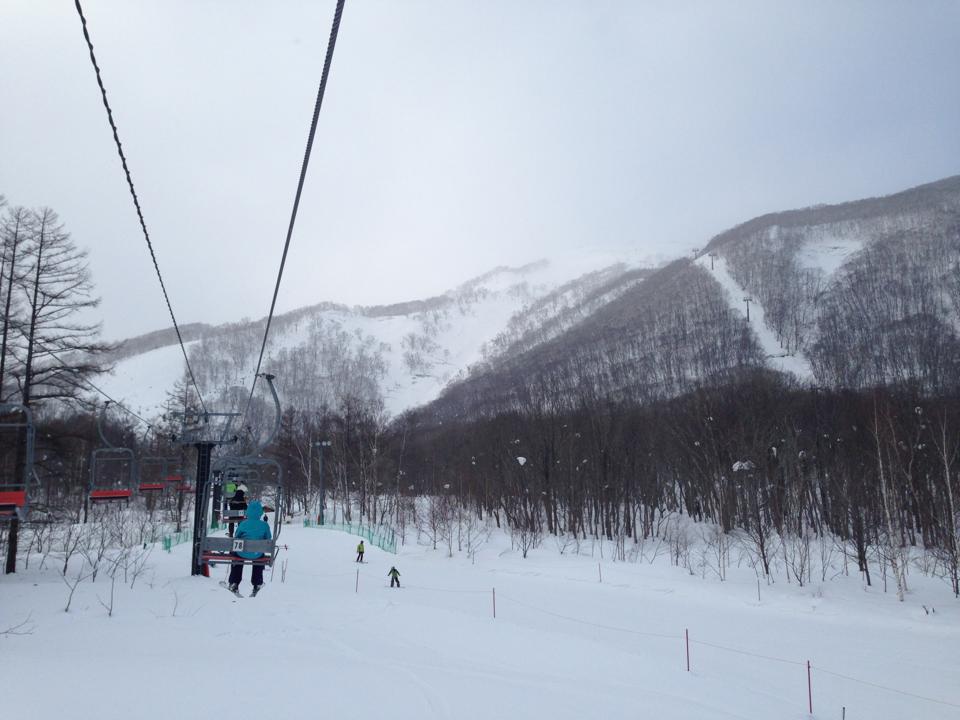
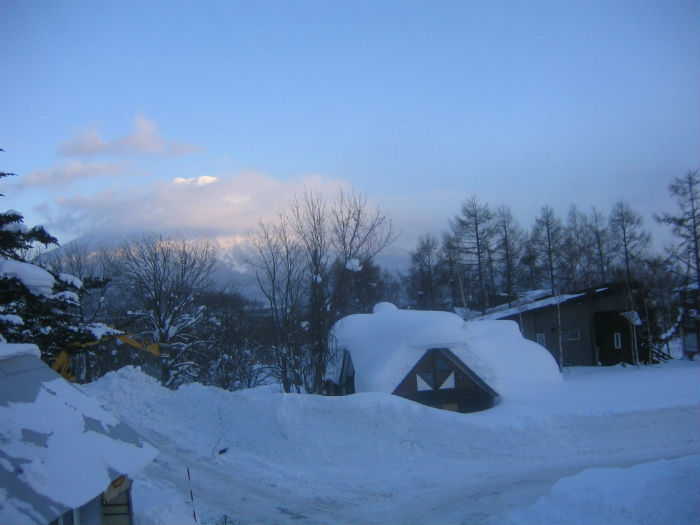
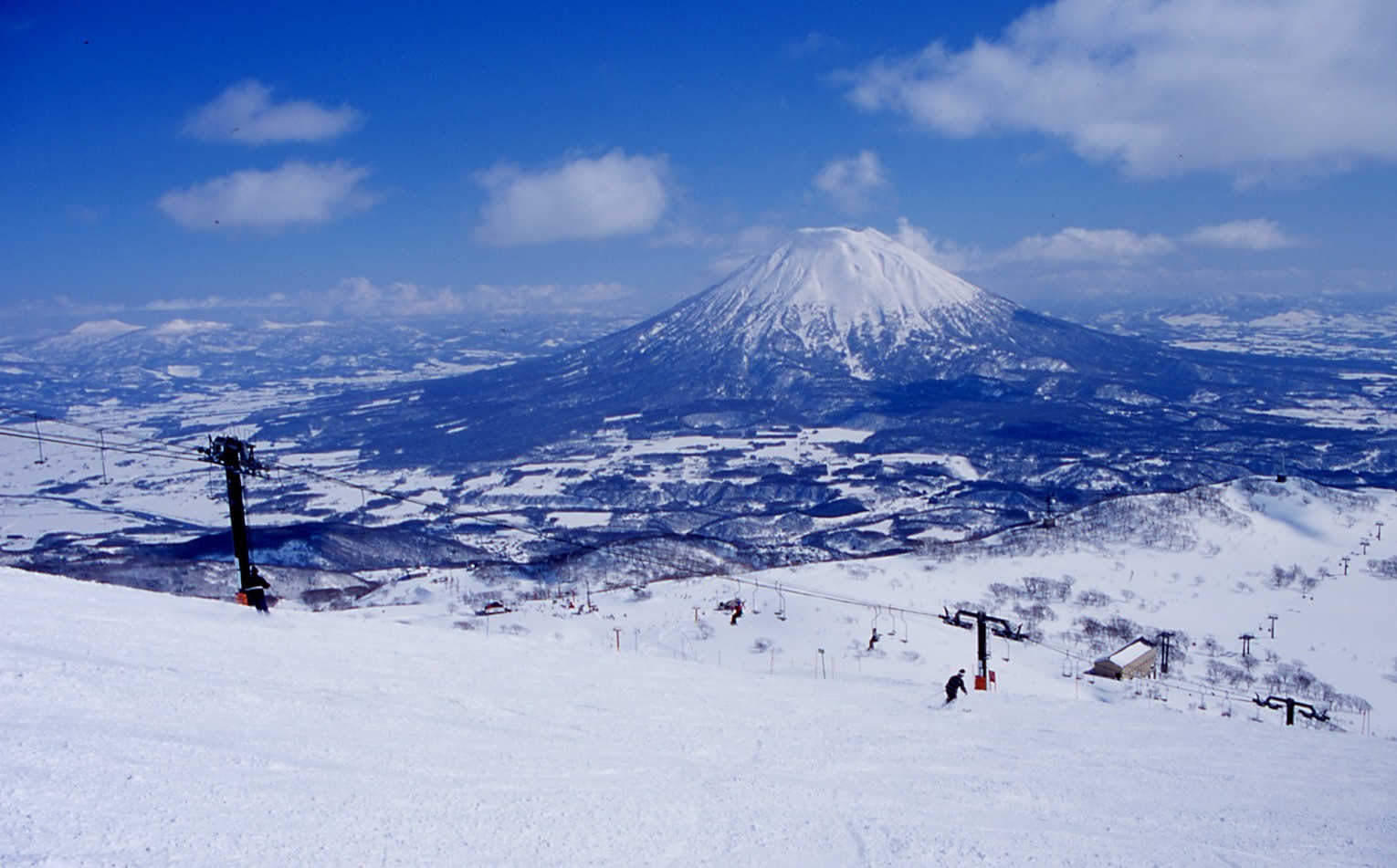
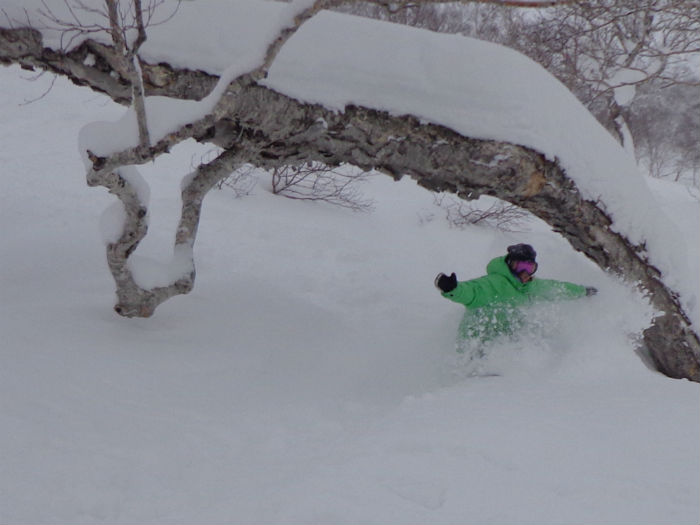
Niseko Ski Seasons : More about the Resort
Learn a little bit more about Niseko United as a destination for your ski season in Japan.
Where is Niseko?
Niseko is located on Hokkaido – the north island of Japan. The closest major city is Sapporo which is around 100km away and it takes about 2 hours to drive between Niseko and Sapporo. A shuttle bus (Hokkaido Resort Liner) from the New Chitose Airport, the major airport outside Sapporo, can take you up to the resort. Niseko is also accessible by train from Sapporo and New Chitose Airport. Note, that during early season when seasonaires often arrive transport options may be limited. The train via Otaru is another option which runs year round.
Mountain and town vibe
Niseko is the name of both a town and the ski area, and so can be confusing. Niseko town is actually a small town, about 7km (20 minutes) from the closest ski area.
There are four main resorts which make up the Niseko area, all of which sit on, and are carved out of, a giant volcano. The four areas are Hanazono, Hirafu, Niseko Village (formerly Higashiyama) and Annupuri. Hirafu and Hanazono combined are referred to as ‘Grand Hirafu’. There is a smaller fifth area which is connected as well, Moiwa, but this area requires a separate lift ticket.
The main service and administrative town is Kutchan which is approximately 20 minutes from the main ski resort village of Hirafu. The next biggest town is Annupuri, followed by Niseko village and the smallest town, Hanazono. Most tourist and nightlife activity is found in the village of Hirafu.
The towns in the Niseko area are more westernized than other Japanese resorts, given the large number of foreign visitors that come through each year. You won’t have an issue getting around without speaking Japanese. English is widely spoken by staff at restaurants and accommodation and signage is in English.
There are a large number Australians, in particular, who come to Niseko each year to ride or work, and it can feel very Australian at times. Because Niseko is so popular, it is not as cheap as other Japanese resorts. Hirafu is the most westernized of the resort areas. Nonetheless, Niseko is still distinctly Japanese and working there allows you to experience some of the Japanese culture for a season.
Mountain Terrain at Niseko
All resorts at Niseko are located on the side of Niseko’s famous volcano and are linked up with each other. This means that, although the resorts are separate from each other, a day riding could lead you to any of the 4 main resorts of Niseko. Between the four main resorts there is a large amount of terrain and there is more than enough terrain at Niseko to last a season.
Hanazono and Hirafu combined or ‘Grand Hirafu’ is the largest of the resort areas. There are 34 runs here, the longest being 5.6 kms (4 miles). There are a lot of open cruisers and access to some of the best powder runs at Niseko. Strawberry fields at Hanazono is as close to back country you can get in-bounds. Although backcountry access is restricted at Niseko due to avalanche danger, there is a lot of side country and other off-piste riding which is permitted which means a good variety of terrain. Annupuri probably has the best variety of terrain of the resort areas.
Niseko does not have the huge steeps and cliffs like in North America or Europe and there is not much in the way of big mountain terrain with rocks and cliff hucks. Instead, come to Japan for its awesome powder. It absolutely dumps down with snow in Niseko. It seems like every day there is a foot deep of fresh powder, and it has happened that so much snow has dumped down that lifts have been covered. Make sure you bring the fat boy powder skis or get yourself a wide board to ride the incredible powder.
Niseko Total Mountain Stats
- Vertical: 1009 m (3,310 ft)
- Top elevation: Mt Niseko – 1,308 m (4,291 ft)
- Lifts: 35 chairlifts and 3 gondolas
- Longest run: 5.6km
Niseko Ski Season Dates & Weather
The ski season runs from late November until the end of April. Over recent years this seasonal start/opening date has changed due to varied snow conditions. Nearby Rusutsu has in some years opened slightly earlier than Niseko.
Niseko ski area is home to harsh conditions. It gets bone cold and is often -20c with a wind chill factor of another -20c which can put a dent in the fun of the day. Often the light runs out at about 3pm which means heading in early. Also, there are not too many clear days at Niseko and it rarely sees sun. However, the fact that it snows almost every day and there are seemingly always freshies goes some way to making up for the lack of sun!


